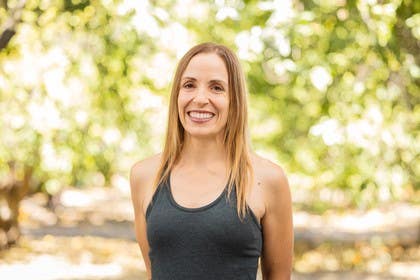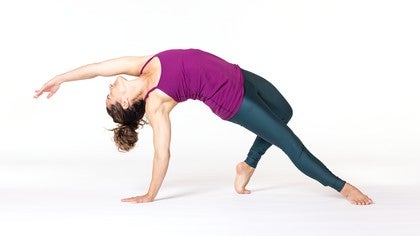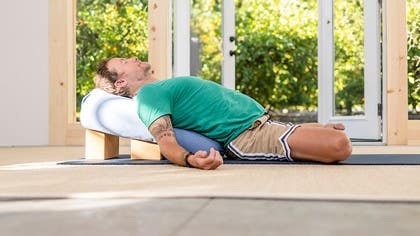
Holey Bones! Practicing Yoga with Osteoporosis
Yoga teaches impermanence, that all things come and go but the soul. Sure enough, even our bones undergo constant change. Like the falling of leaves in autumn and the new growth of spring, bones break down and rebuild themselves our whole lives. Until our mid 30s, bone growth outpaces bone loss, and then the pattern reverses itself. Bone density starts to decline—think honeycomb with expanding holes.
Osteopenia is the name of the condition when the bones are weak for one’s age, and if that weakness progresses to levels that increase risk of fracture, the diagnosis is osteoporosis, literally "porous bone". Osteoporosis affects 54 million Americans, and over the age of 50, it is the cause of fractures in one in two women and up to one in four men.
Pervasive as the condition is, we typically don't know our bones are losing density until we break one, giving osteoporosis the nickname of “silent disease". Since fracture begets fracture, early intervention is key, especially if you are over the age of 50, female, small-framed, and have a family history of the disease.
The good news is that we have some control over our bone density. In addition to diet and medication, research has shown that certain aspects of physical activity make our bones stronger, such as weight bearing, muscle strengthening, balance training, postural awareness, and functional exercises. Yoga includes them all. In his research, Lawrence Fishman, MD, found that a 12-pose yoga sequence for patients with osteoporosis outpaced medication for building bone density and without unwanted drug side effects.
More research is needed, however, Dr. Fishman proposes that yoga is effective because it places multiple force vectors on the bones. In asana, we play a kind of tug-of-war with our bones and muscles by co-contracting, or “hugging the bones", as well as by working in opposing ways, as when we lengthen the spine in a forward bend.
Below, find five ways this plays out in your yoga practice.
1. PostureAlignment fans out there, you are in luck! Form matters, especially when it comes to the spine. Thoracic compression fractures, the most common type of fracture resulting from osteoporosis, are more likely to occur when your upper back is rounded—yup, the slouch. Research shows that strengthening the spinal extensor muscles to lengthen the spine from rounded back to neutral reduces risk for compression fractures.
Poses like Salabasana (Locust Pose) directly strengthen those muscles, and poses like Tadasana (Mountain Pose), the Virabhadrasanas (Warrior 1, 2, and 3), and any of the “Ardha” movements in forward bends help us apply spinal extensor strength to poses that mimic everyday functional movements. The idea is to apply your felt sense of a lengthened spine to as many movements as you can, both on and off the mat. Bending over to pick something up? Instead of rounding your back to lower yourself down, bend your knees and keep a long spine.
2. Muscle strengthening/resistance exerciseYoga is chock full of muscle strengthening exercises, with the resistance being your own body weight in different relationships to gravity as well as the intricate muscle actions that refine each pose.
Utkatasana (Chair Pose) can be used to strengthen the muscles of the thighs and hips while weight bearing through them, thereby strengthening the femur bones which are the second most common fracture site resulting from osteoporosis. Further you can use Utkatasana to teach proper functional movements. Take a chair behind you. From Tadasana with feet hip distance apart and arms overhead, bend your knees to Utkatasana. Reach the tailbone back and down to avoid spinal rounding, lift the chest, and look forward. Then see if you can hover over the chair and maybe even sit down with control, light as a feather. From there, hinge at your hips, back to Utkatasana, then Tadasana. That’s a yoga mini-sequence but also considered one of the most useful exercises for osteoporosis because it teaches not to slouch in sit-to-stand and stand-to-sit, the latter of which frequently causes compression fractures when done poorly with osteoporosis. 3. Weight bearingMany yoga poses are done standing, producing weight bearing forces on the bones of the legs, pelvis, and spine. Moreover, yoga is one of the few exercise forms where you’ll find adults standing on their hands. Wrists take third place for the most common fracture sites resulting from osteoporosis. Down dog too much? Even just being on hands and knees provides weight bearing forces through the wrists. Or stand up and place your hands on a desk and rock forward and back. Inversions can also be useful - however a word of caution here. If you are new to yoga or have any doubt about your ability to maintain a neutral spine in inversions, you should consult your physician before practicing them.
4. BalanceFall Prevention—that’s your big winner with balance exercises . If we have weak bones that are susceptible to fracture, we need to reduce our fall risk. The strengthening already discussed is one aspect of balance, but there are many more pathways in the body that can be challenged to improve balance like vision and the workings of the inner ear. A classic yoga balance pose is Vrksasana (Tree Pose). But even standing with two feet joined together in Tadasana (Mountain Pose) can be a challenge, and if not, try closing your eyes. Practice tip: There’s a fine line between challenging your balance systems and falling while doing so. Be conservative—practice with your back to the wall or place your hand on a chair. You can always shift away from the wall or float your hand off the chair if you feel stable.
5. Functional ExercisesTaking yoga off our mats and into our daily lives is one of the true gifts of the practice, physically and psychologically. Many actions in the poses can be applied to everyday life to support safe movement and build stronger bones.
Though holey bones are here to stay, an informed yoga practice done methodically and consistently makes the holes smaller and a sense of the holiness of life much larger.
Comments
You need to be a subscriber to post a comment.
Please Log In or Create an Account to start your free trial.














